|
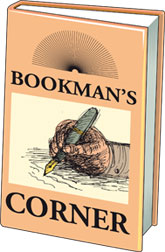
Exposition of a difficult concept in Buddhism
Reviewed by R. S. Karunaratne
Nirvana Now, subtitled One Truth, Many Paths is an unusual book that
deals with Buddhism, Hinduism, Jainism, Yoga, Tantra and Viveka. The
blurb appearing on the back page says, "Mahaguru - the world's top-notch
yogi and Viveki - is the enlightened guide to millions of ordinary
people around the world. Understandably, he is a man reviled by priests
and politicians."
Many books have been written explaining how to attain Nirvana. Rarely
do we come across a book which describes what Nirvana is. In this book
the author has shed some light not only on how to attain Nirvana but
also what Nirvana is. Yoga International News of London says the book is
"a must read for the genuine spiritual seeker".
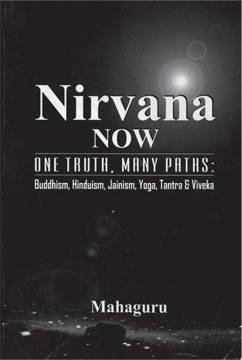 |
|
Author:
Mahaguru
Publisher:
Buddhist Cultural Centre,
Nedimala, Dehiwala |
Mahaguru says, "There is a universal architecture of infinite
elegance and logic from which all things animate and inanimate seem to
have derived. It is called Nirvana. The official definition of Nirvana
is, "It is a state of neither being nor not-being, a state where all
wishes have been fulfilled.
This is in full agreement with the view of Nirvana held by Buddhists.
For instance, a person who attains Nirvana remains blissfully neutral
among all opposites. Such a person will experience a great void and
becomes a 'radiant light' that will not die. Nirvana in Sanskrit or
Nibbana in Pali means "to blow out" the fire of human suffering.
Chapter 2 entitled "Nirvana according to the Jains" is both
interesting and illuminating. According to the author, Buddhism and
Jainism were accepted by the people as being not mere philosophies but
religions.
These two systems became major spiritual forces in the world, mainly
because they relied on self-salvation and had nothing to do with a
creator God. The comparison of Buddhism and Jainism is noteworthy.
The author says that the word 'Nirvana' is derived from the old
Indo-Aryan Sanskrit 'Nir' meaning 'out', joined with the root 'Va'
meaning 'to blow'. Theravada Buddhists often give the example of blowing
out a flame of light. The author's question is pertinent: "Then what
would happen to the four-fold elements and the gases that made the
flame, after it had been extinguished?"
Mahaguru has discussed the concept of Nirvana according to the
Kundalini Yogis, the Tantrics and the Vivekis.
He seems to have done a lot of research into the subject. Some
readers may not agree with his views which are unorthodox and
intellectually challenging.
Whatever views he puts forward, Mahaguru has explained them
logically.
If anybody wants to find the answers to the following questions: What
is Nirvana? What happens to a person in Nirvana? What should one do to
attain Nirvana? Nirvana Now is an ideal book to read.
How to live happily in retirement
Reviewed by Jagath Pieris
I was prompted to write a review of this book purely because of an
experience I had with Visrama Suvaya.
I live in Washington and my parents who retired as Sinhala trained
teachers in Sri Lanka now happen to live with me. On my last visit to
Sri Lanka I was looking for some books to be brought to my parents who
read only Sinhala and amidst the books I purchased was "Visrama Suvaya"
by Dr. Nimal Sedera. I observed from his write-up that he too stays in
Las Vegas now.
I was surprised in the interest taken by my parents in reading the
book Visrama Suvaya. Especially my father commented that there is no
such book written in Sri Lanka for the Sinhala readers. Both of them
said that they were able to identify several problems they had in their
retired lives through Dr. Nimal Sedera's book.
Their lives truly changed. Their daily routine changed. They became
happier people.
They were not very happy staying away from home in Sri Lanka until
such time they read this book. So much so, my wife calls it the miracle
book. My father said when he had to retire and stop going to school he
did not know how to handle time, the extra hours he has due to no work.
There had been arguments between by mother and father due to this
problem of not knowing what to do with their spare time.
Having read Visrama Suvaya my mother has begun to write her life
experiences as a teacher. My father is plotting his life story and I
have promised him that I will make arrangements to get it printed in Sri
Lanka.
Both began to read the Sri Lanka newspapers through the internet
which they never did before. This too keeps them occupied and they
discuss the news and the articles they read in the daily Sinhala papers.
Infact they relate us news of Sri Lanka as we hardly have time to read
it.
They attributed all the change in their lives to Dr. Nimal Sedera's
book Visrama Suvaya. They recommended the book to some of their retired
friends in Sri Lanka, as well.
It is at this point I took this Sinhala book to my hands. I read a
Sinhala book after several years and I am happy that my reading speed
has not reduced so much. I am fifty-one and it is the first time I read
a book related to retirement. I felt frightened that I have overlooked
some key things in my life to enjoy a happy retirement. There had been
some things that I should have begun to do to reach a successful
retirement. Better late than never. Dr. Sedera's book is written in
simple Sinhala and it has true life experiences discussed mainly of his
family and parents. It makes the book interesting.
I contacted Dr. Sedera via the internet and was able to thank him for
writing this book in Sinhala related to him and how this book has been
helpful to my parents. It is at this point Dr. Sedera suggested to me to
write the story so that he could send it to the press in Sri Lanka. I am
sure that this is the best gift that can be given to anyone due to
retire or to one already retired.
Vasidiya Bandun by Upul Senadhirige :
A rich poetic tapestry
Reviewed by Ranga Chandrarathne
Vasidiya Bandun, a collection of poetry by Upul Senadhirige is a
seminal collection of poetry which sheds insights into the contemporary
milieu. One of the prominent aspects of Senadhirige’s poetry is the
cross allusions, ranging from world literature to the ancient Sinhalese
classical literature.
It is obvious that the poet appreciates not only the Western classics
but also great creations of paintings and music. This is, perhaps,
resulted in his rich sub-texts in poetry with myriads of allusions.
However, his forte seems to be in his ability to condense those
multitudes of allusions to make them relevant in contemporary context.
At most of the times, they are social criticisms spreading over a
large canvas of society with political connotations. Poet expresses
sympathetic views about the victims of circumstances. For instance the
poem entitled Prathirava Nanvunida Nube That.. (Do your strings
echo...?), is about a street mandolin-player who plays his mandolin at
the threshold of a tavern. It should be mentioned here that the plight
of the mandolin-player in Sri Lanka is quite different to the plight of
street mandolin-players in Europe. In a way the apt title of the poem
sums up the plight of the street musician who leads a hand to mouth
existence.
“Do your strings echo …?
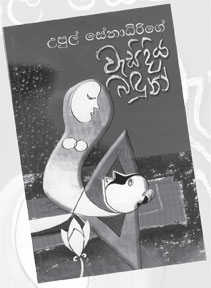 You are not a dwarf of flower You are not a dwarf of flower
Holding a lotus stick
A young musician holding a Veena
Like a guarding stone by the tavern door
Emanates from your mouth a melodious tone
The innermost agony of your soul
Does you, the minor singer desire
For a sip of wine
In the seclusion in the middle of the tavern
Search for the contours of a bubble
A clouds of smoke emanates
Through the gust of wind from the fans
Search for a poem on a weary face
A minor sign of a sad metre
Then heard a collection of Baila songs;
Eirin ,Joshopin and Magiline
…..
The rough teeth which had not felt
a touch of stick of brush
Faded cloths soaked in perspiration
Murky eyes with a grown up beard
The face like that of a clown
Touching on the broken strings of the mandolin
With a weary and aged face
Searching for the broken rhythm of life
Though the wet strings make a sound in the heart
Do the echo of your strings
Feel the strings of the Veena
In the heart of such men “
(Veena, a string instrument of music in the Indian traditional music)
Even in this poem, the poem alludes to Sinhalese classical
literature. For instance, the poet refers to Padma Vamanaya or dwarf of
flower who plays a Veena with a lotus stick. The crux of the poem is
that people, who are engrossed in liquor and devilled meats, are not
sensitive to the plight of the street singer who plays his broken rhythm
of life. Through the use of apt metaphors and classical allusions, poet
recreates an ambiance of a pub which is filled with smokes from the
burning cigarettes and the mixed aroma of roasted meat served on plates.
In the poem ‘Sonduru Gamaka Peraliya’ (Transition of a pastoral
village), the poet captures the socio-economic changes that had taken
place in the village of Koggala where Sinhalese premier writer Martin
Wickremasinghe was born. The village has changed over the years; now
instead of a sleepy village that Martin Wickremasinghe portrayed in
Gamperaliya, is a tourist designation with a host of hotels, motels and
villas emerging from every nook and corner of the village. Generation of
beach boys ‘guides’ with tattoo on their hands, inquire the visitors in
German about their needs.
One of the prominent themes of the collection is politics and the
poet expresses his views in no uncertain terms when he mentions that the
change of Constitutions is like changing framed picture on a wall. The
imposing pictures of different figures will change from time to time but
the old wall will remain. Though there are faces similar to dictators
such as Mussolini or Hitler, the poet questions will the day ever dawn
when a picture similar to those of Martin Luther King or Gandhi hang on
that wall.
“ …. Was there a face like those of Martin Luther king
or Gandhi hang on the wall? “
The title poem is a translation of Bob Dylan’s song ‘Buckets of
Rain’.
"Buckets Of Rain"
Buckets of rain
Buckets of tears
Got all them buckets coming out of my ears
Buckets of moonbeams in my hand
You got all the love honey baby
I can stand.
I been meek
And hard like an oak
I seen pretty people disappear like smoke
Friends will arrive friends will disappear
If you want me honey baby
I'll be here.
I like your smile
……
-Bob Dylan “
It is important to compare the original song with the translation. In
the Sinhalese translation, poet’s ability is amply manifested when he
translated original English lyric into lucid Sinhala with a unique
metre.
“
Buckets of rain
Buckets of tears
Got all them buckets coming out of my ears
Buckets of moonbeams in my hand
You got all the love honey baby
Vasidiya Badun
Thethi Kadulu badun
Vahe eka lesin
Thulin ma savan
Sada kan bandun
Ma athla matin
Siyaluma senekam
Madumathiya..!
Radenu ma langin “
One of the unique characteristic of an excellent translation is that
the translation itself becomes an excellent piece of literature in the
target language. The Sinhalese rendering of Bob Dylan’s lyric ‘Buckets
of Rain’ manifests qualities such as originality and the poet’s forte is
that he has used classical Sinhalese idiom in translating the English
lyric into Sinhalese. For instance, the poet uses the world ‘
Madumathiya ‘ for the English world ‘honey baby’. If the poet has stuck
to the word for word translations, a common practice among most of the
Sri Lankan translators, Sinhalese poem would have been a mere collection
of words.
Upul Senadeera’s rendering of Bob Dylan’s song ‘Watching the river
flow ‘is also an excellent translation.
“ Watching the river flow
What's the matter with me,
I don't have much to say,
Daylight sneakin' through the window
And I'm still in this all-night cafe.
Walkin' to and fro beneath the moon
Out to where the trucks are rollin' slow,
To sit down on this bank of sand
And watch the river flow.
….
Bob Dylan “
“ Ma degidiyavaka pasuvanu vina
Vadi yamak kiyanu nohe
Uda Avue Alliyaka
Daga karai ma’ kutiye
Raya pura nidivara avanhala tulata vee
Gim nivami ….
“
The translation of the first couples of lines of the lyric amply
demonstrates the innate talent and the use of appropriate metaphors and
classical Sinhalese idiom in the translation. It is obvious that the
mature poetic diction comes from the wide reading of not only Sinhalese
classics but also from the poet’s ability to appreciate diverse forms of
art such as music, drama and paintings. For instance, most of the poems
are inspired by diverse forms of art. The poem Kukulan Ketaveema is
inspired by the abstract painting ‘Cock fighting’ by C.Williams. This is
a rare instance that a poem is written inspired by a painting. The poet
pains a word picture about a cock fighting. The poem Anga is inspired by
Eugène Ionesco’s play ‘rhinoceros’.
The poems such as Galumuva dora dee ( At the Galle Face green) stands
out for their use of novel metaphor often taken out of the contemporary
milieu and in a manner representing the landscape of Galle Face green.
“On the line of black tar in the heart
The people lined up with thousands of slippers and shoes
Trampled the weary thoughts … “
Beyond the superficial description of festivity in the Galle Face
green and the busy traffic alone the Galle road, what the poet portrays
is the stark reality of poverty and deprivation and grand illusion
created by the festive air.
Upul Senadirige’s poetry stands out among contemporary Sinhalese
poems for their insights thrown into the milieu and the use of rich
poetic diction which is highly influenced by classical Sinhalese
literature and novelty of metaphors that the poet has devised out of the
milieu. In his rendering of English poems and songs to Sinhalese, the
poet has used his unique poetic diction laced with novel metaphors
making them truly master pieces in Sinhalese. However, the poet has
captured the elements of cultural nuances in the original in a manner
preserving the spirit of the original work. One of the prominent
features of the collection Vasidiya Badun (Buckets of rain water) is the
diverse sources of inspiration that the poet derived for his poems.
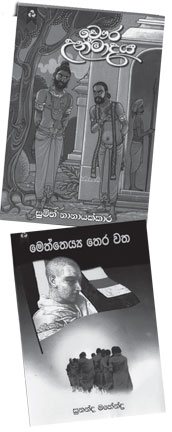 BOOK LAUNCH BOOK LAUNCH
Chaura Unmadaya
Sumith Nanayakkara's latest Sinhala novel Chaura Unmadaya will be
launched at Dayawansa Jayakody Bookshop, Colombo 10 on May 24 at 10 am.
The author's Sinhala novel Magam Soli won the first prize in a
competition organised by the publishers.
Chaura Unmadaya is a Dayawansa Jayakody publication.
Metteiya Thera Vatha
Prof. Sunanda Mahendra's latest book Metteiya Thera Vata was launched
at Dayawansa Jayakody Bookshop, Colombo 10 recently.
Prof Sunanda Mahendra is the author of several other books such as
Devdath Mavata Manavi, Dangara Tharappuva, Unu Alu Palla. Niruvath
Devivaru and Niralambanaya.
Metteiya Thera Vatha is a Dayawansa Jayakody publication.
Your Home Studio
Your Home Studio , a book on computerised music studio techniques by
Lakshitha Mataraarachchi will be launched on May 27 at the Public
Library auditorium, Colombo. A well-know composer Nawaranthna Gamage
will address the gathering.
'Ingredients of Happy Childhood'
A lecture entitled “Ingredients of happy childhood “ by the director
of Tokyo Children’s Library Kyoko Matsuoka, the author and translator of
Sybil Wettasinghe’s The Child in Me into Japanese, will be held at the
Sri Lanka Foundation Institute, Colombo 07 today at 4.30 p.m. Dr.
Gunadasa Amerasekara will be the chief guest at the event. Colour
editions of The Child in Me and its Sinhalese version Weniyan Kalu
Weniyan and Sybil’s latest publication Pulun Baba will also be launched.
NEW ARRIVALS
Remembering Rabindranath Tagore
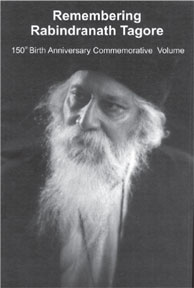
150th birth anniversary commemorative volume
The commemorative volume is published by the University of Colombo
and compiled and edited by Sandagomi Coperahewa. The volume contains
scholarly articles on the life and times of Rabindranath Tagore and his
unique contribution to art and culture.
Kaluvarai Purahanda
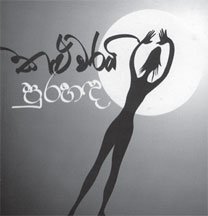
Kaluvarai Purahanda is a novel by Anura Siri Hettige and is published
by Sadeepa Publishers.
Egilennatuva Piyabanna
Egilennatuva Piyabanna is collection of articlwes on diverse themes
ranging from cinema, short story and novels. The book is published by
Sarasavi Publishers. |

